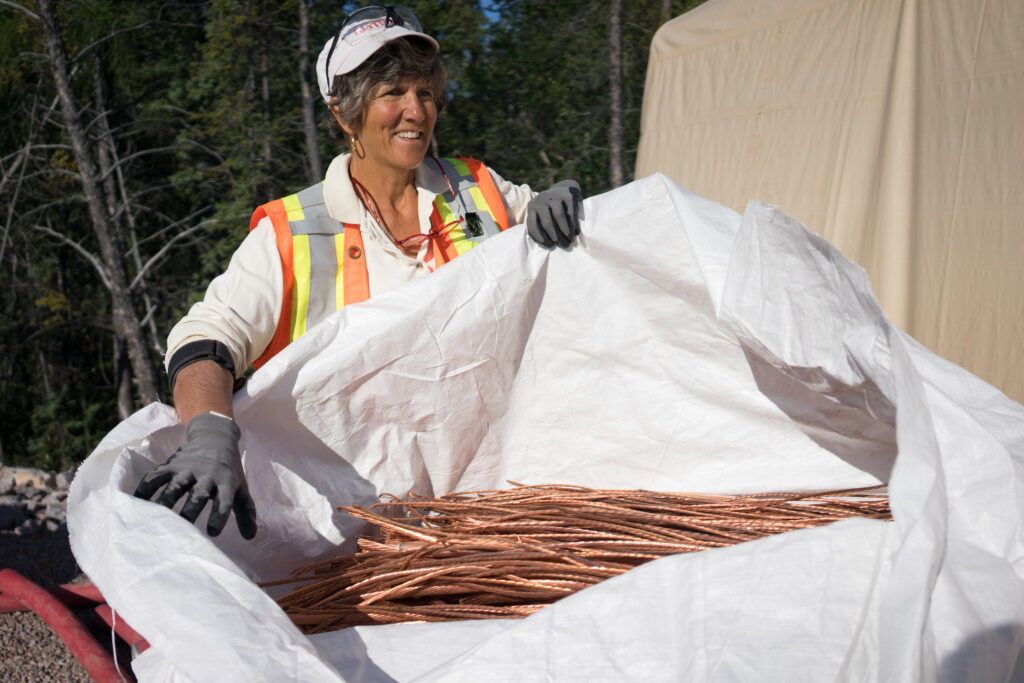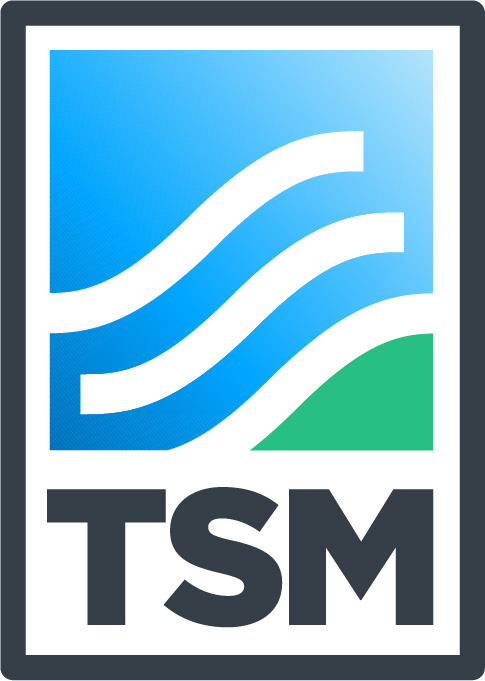
Each year, the TSM Excellence Awards highlight outstanding community engagement and environmental initiatives at facilities that are implementing TSM. The awards selection committee, comprised of members of MAC’s national Community of Interest Advisory Panel, received several excellent nominations for the awards and acknowledged the range of important sustainability initiatives being undertaken by Canadian mining companies. This year, the committee chose to highlight the projects that they felt to be truly innovative and demonstrative of leading practice. This led to the identification of one winner and two finalists in the Community Engagement category and a single winner in the Environment category.
TSM Environmental Excellence Award
Winner – New Gold’s New Afton Mine Leading the Way in Energy and GHG Performance
With the rapid move to electrification of the transportation industry, sustainably produced copper is essential. As an energy intensive industry, reducing climate impacts from the mining process is important for sustainable production.

New Gold as a company is leading the way in its commitment to greenhouse gas (GHG) reduction. The New Afton Mine is both AAA verified in the TSM protocol for energy and GHG management and is also the first and only mine in North America to be certified to the International Standards Organization’s (ISO) 50001:2011 Energy Management Standard.
Leading programs like TSM and ISO are well-established and widely respected as top-tier standards. When standards like ISO 50001 and TSM are met, this means energy management practices are at the highest level. New Gold’s New Afton Mine is also continuously trying to improve through the application of innovative new technologies and best practices, with the support of its Indigenous Partners and employees.
Companies who achieve ISO 50001 are widely recognized as being top performers in sustainable operations. Since first committing to ISO 50001 in 2014, New Afton has achieved annualized energy savings equivalent to 15% of its total 2021 energy consumption, and substantial GHG reduction. This is partly due to the mine’s adoption of low-carbon technologies, including the continued electrification of New Afton’s underground fleet via the use of battery electric trucks and loaders.
Combined with its TSM results, the ISO 50001 achievement represents the company’s dedication to lessening its environmental footprint and will hopefully inspire other companies in the industry to do the same.

TSM Community Engagement Excellence Award
Winner – Community Engagement at Diavik Mine Turning Copper into “Gold”
With demand for minerals and metals presently increasing, due in large part to their essential nature in low-carbon technologies, ensuring there is enough supply to enable the global energy transition is imperative. In addition to mining new deposits for materials, like copper critical to green tech, the need to increase the rate at which metals are recycled is high, and there is an opportunity and growing need to do more.

Transitioning to a cleaner economy starts with modifying practices and technologies to create economic opportunities out of the materials that might otherwise be thrown away. This is the essence of what is known as the “circular economy”, the idea that supports business practices that extract as much value as possible from resources by recycling, repairing, reusing, repurposing, or refurbishing products and materials — eliminating waste and GHG emissions. Rio Tinto’s Diavik diamonds mine exemplifies circular economy best practices through partnership and local community engagement, both central tenets of Towards Sustainable Mining’s Indigenous and Community Relationships and Climate Change protocols.
Several years ago, employees at Diavik recognized an opportunity to repurpose copper wire from predominantly completed underground mining levels. A core group of passionate employees took the initiative to propose to Diavik to salvage copper wire where possible, and collect it in containers for transport off-site to donate to community groups. Diavik endorsed this idea and included this activity as part of scheduled work, so those who volunteered were paid for their time. This project worked to a small extent but grew substantially when, in 2019, Diane Haché, a retired employee, and her partner Michel Tremblay, a current employee, led the volunteer efforts to maximize the mine’s recycling efforts, through stripping and shipping of the salvaged copper for sale, with all proceeds going towards Diavik’s Community Contribution Program. Since the project’s inception, the results have been significant, raising over $500,000 for local charities like the Stanton Territorial Hospital Foundation, YWCA NWT, HomeBase Yellowknife, Arctic Indigenous Wellness Foundation, and NWT On The Land Collaborative, and diverting roughly 225,000 pounds of copper cable from the landfill.
This community-led project continues to expand, and in 2022, the Common Ground Crew, an initiative run through the Yellowknife Women’s Society that provides day labour to people experiencing homelessness, was brought on board. The crew worked alongside Diane Haché to process the copper, with wages taken from the proceeds. The initiative provided residents with several hundred hours of employment while also increasing the volume processed.
Diavik has purchased a copper wire stripper to increase the rate and volume of salvaged copper that can be stripped. Further, copper cable can and will be salvaged through the mine’s closure process to go towards recycling and generating funds that can benefit local communities while minimizing the mine’s environmental footprint.
Representatives of MAC’s Community of Interest Advisory Panel were impressed by the significant impact this innovative recycling program has had in the local area, through employment, volunteer opportunities and charitable donations. They also noted how this initiative is providing one of the key metals essential to the green energy transition, copper, by repurposing materials that have already been used – an excellent example of the circular economy at work.

Finalist – Agnico Eagle Closing Gaps in Education Access in Neighboring Communities
More and more frequently Canadian mining companies are ensuring that communities are being provided skills development and training opportunities to ensure they are positioned for future success. Agnico Eagle’s Pinos Altos mine is one example highlighting how education promotion can go hand in hand with community engagement, a central component of Towards Sustainable Mining.
Prior to the construction of Pinos Alto in 2006, the Ocampo Municipality, a community located in close proximity to the mine, offered only limited educational opportunities to the high school level. Students interested in a post-secondary education were forced to move to a different city, far away from their home community, to pursue the training and education essential to improving their career prospects.
In 2015, in efforts to promote further education for local community members, Agnico Eagle supported the development, construction, and operation of the University Cultural Center of Basaseachi, operated in partnership with state and municipal governments. Over the past several years this institution, which offers career skills training and Master’s Degree options, has had a significant positive effect on the local community by providing the opportunity for young people in remote communities to pursue higher education.
Due in large part to the success of the establishment of the University Cultural Center of Basaseachi, Agnico Eagle has continued its focus on education for local community members and in 2020, in coordination with local authorities, helped to open an extension of the Technological Institute of Cuauhtemoc which offers online educational courses. This focus on online education was particularly helpful in meeting the unique needs of students during the COVID-19 pandemic. Agnico Eagle also improved the educational infrastructure of 25 classrooms in 41 local schools to support the growing student population, established a scholarship program that has already benefited 1,254 young people and supported intervention programs to tackle school dropout rates. Approximately 2,760 children and young people continue to study thanks to these new teaching venues.
Perhaps most importantly, these courses allow graduates to develop in their own region, improve the quality of life for their families, and help them create a sustainable community. The generational impact of this initiative is enormous, as young people who wouldn’t otherwise have access to higher education are now, for the first time, able to. The results speak for themselves, with 180 students having completed their Bachelor’s Degree and 13 having completed their Master’s Degree since the project’s inception.
Representatives of MAC’s Community of Interest Advisory Panel were impressed by how Agnico Eagle’s focus on meeting the diverse educational goals of community members is building a lasting positive legacy that will benefit large numbers of young people and lead to greater self-sufficiency.

Finalist – Raglan Mine Trail Marking Project Enhances Community Engagement and Safety
Climate change is undoubtedly one of the most critical issues facing the world today, and impacts are already being felt, particularly by communities in Canada’s North. With warmer temperatures causing ice to melt at a higher rate, Indigenous communities located in northern regions have had to adapt as their trails, traditionally used to access hunting and fishing areas, become less safe to utilize.
Over the past several years, Nunavimmiut in Nunavik have found that culturally significant trails, essential to enabling community members to hunt for food that can only be accessed by snowmobile or ATV, have become more dangerous due to melting ice and warmer temperatures. In 2017, trail marking, a process used by Glencore’s Raglan Mine that involves marking roads with flags to ensure better visibility in case of bad weather, was identified by local leaders in Salluit who were interested in utilizing the same technique for trail access in their community.
In order to assist the community in its work to improve the safety of its infrastructure and members, Glencore started providing information, financial contributions and donations of flags and poles to address the need to enhance safe hunting and fishing trail access. This partnership demonstrates how effective Indigenous engagement can bring positive benefits in terms of health and safety to community members and aligns with the Towards Sustainable Mining (TSM) requirement to identify risks faced by affected communities alongside benefits they would like to pursue from their relationship with a mining company. TSM further requires companies to work with those communities to prioritize and work together on those identified risks and benefits, a goal clearly realized in this initiative which has been so well received that it was expanded to include Kangiqsujuaq, Glencore’s second host community, in 2019.
In addition to enabling safe access to areas essential to the survival of local community members, these projects have also created employment opportunities related to administration, installation and sewing of flags at the local sewing center – not to mention the interesting business opportunity to sell the locally made flags to Raglan Mine, providing important economic benefits.
Every day, land users take risky paths to hunt and fish not only for themselves, but for their communities. By helping the communities put the trail marking program in place, sharing company knowledge, and providing donations and funding, the project has changed, and undoubtedly protected, the lives of many. Today, people that go hunting or fishing do not have to face the same level of risk as they used to just a few years ago.
Representatives of MAC’s Community of Interest Advisory Panel were struck by how this project highlights how host communities and industries can work together to achieve key goals, especially when it has a direct impact on the health and safety of individuals. As the world continues to adapt to the impacts of climate change, it will be important to see more initiatives like this that improve safety while also encouraging traditional pursuits.

